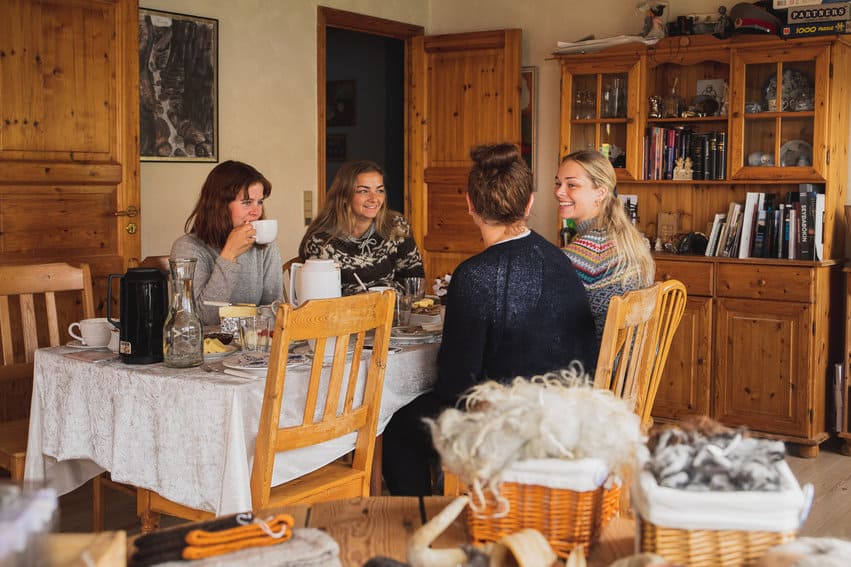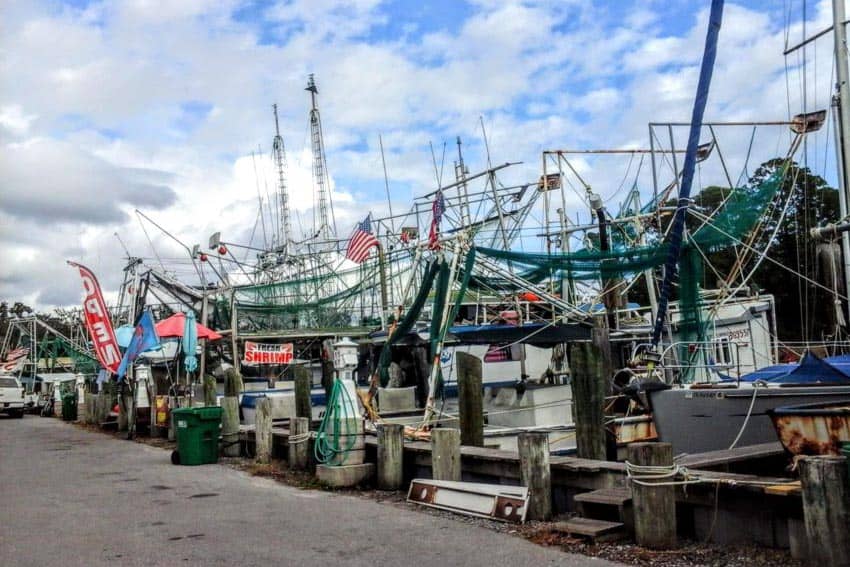
Curious Appetites Meet Faroese hospitality
By Chin Liang Teh
Senior Writer
It was a grey Sunday afternoon. Bone-chilling wind whipped through Tórshavn, hammering rain against the turf roofs. The dreadful weather in this the Faroese capital did not deter the long lines outside the restaurants.
dreadful weather in this the Faroese capital did not deter the long lines outside the restaurants.
People knew it was worth the wait to check off their to-do list: taste the authentic Faroese food.
The sight was common on Sundays in Tórshavn. Hordes of tourists throng the fully booked restaurants. Ragnhild and Jóannes drove by the town that day, and saw people being turned away from a restaurant.
Then a thought hit them – they knew what they could do for these people – that is to bring them to a local home!
Home Hospitality in the Faroe Islands
Home hospitality has existed in the Faroe Islands for many years, but a lack of hosts and inadequate organization have made it difficult for tourists to find a host to dine with.

“We are not restaurant owners, but what we saw that day filled us with inspirations. With only a small population on the island, it is easy to get in touch with everyone around here. We can bring locals to provide a truly authentic culinary experience to tourists,” Ragnhild and Jóannes said in a recent interview with me.
Culinary Roots Run Deep
”First, we built the booking platform EatLocal and brought on board a mix of existing and new hosts. Visit Faroe Islands helped us reach our target audience through their extensive marketing channels.”
Through Hugskotið, an entrepreneurial platform that promotes the development of a diverse business community in Tórshavn Municipality, Ragnhild and Jóannes had a chance to connect with like-minded people, who helped them further refine their idea.
Faroese people are known for their culinary prowess. In the windswept villages throughout the Islands, the kitchen always smells of warm harvests, blending with the delicious aroma of skillfully cooked meat and the tangy hint of smoked fish. Best of all, 100% of the ingredients are sourced from homegrown farms
Farm-to-the-table dining experience

Sustainable tourism has been a longstanding practice in the Faroe Islands, where environmental protection takes center stage in every government initiative. When bottled water suddenly took up shelf space in supermarkets, locals frowned at the sight, not understanding why tourists would choose it over tap water that is known for its unrivaled purity.
”Many people see it as a waste of plastic and resources when fresh spring-fed water is simply a turn of the tap away. it’s counterintuitive!” Ragnhild and Jóannes laughed at the reminiscence.
”The local beer is brewed with sparkling fresh water. It tastes fantastic. You get these crisp notes and an earthy aroma that just goes perfectly with the rich Faroese dishes,” Jóannes added.
”Since its inception. EatLocal has received a positive response, largely due to the warm hospitality and open-mindedness of the Faroese people. Many opened their homes to strangers and and shared both their culture and culinary traditions,” Ragnhild said.
The locals’ doors are now open to visitors
The onboarding process for new hosts includes a detailed explanation of the program’s requirements, with a strong focus on authentic Faroese food.
”Most of the time, we do not have to explain much because many locals get it right away. They know what a tourist wants.”
Many guests enjoy trying unique Faroese dishes such as dried fish, dry whale meat, and various seafood. They are open to trying everything on the table.
Exquisite Tastes of Faroese Cuisine
”Some of our hosts would go out of their way to offer a small starter that includes quintessentially Faroese dishes like fermented lamb, fermented fish, and a variety of locally grown produce such as potatoes, carrots, curly kale, and other vegetables sourced from the region.”

These starters are a welcoming prelude to stimulate guest’s taste buds and delve them further into the heart of Faroese cuisine.
”For starters many guests would like to try our dry fermented meat from sheep, called “Skerpikjøt”. It comes from the leg or shoulder of Faroese sheep. After the sheep is slaughtered, the meat is kept in a cool place, usually a storehouse. Many Faroese homes have a storehouse where they store meat, fish, and other items. ”
The main courses often consist of succulent lamb, slow-cooked to melt-in-your-mouth tenderness, or pan-fried cod, haddock, or salmon, complemented by a side of Faroese potatoes.
”I remember a guest told us that he never liked lamb, but after taking the first bite of our Faroese roast, his eyes widened, and said: Now this is something!”

”We have a special way of cooking our lamb — it’s not the typical lamb you’ve eaten. Each family has its own secret recipe that has been passed down through generations. Some serve it with a dollop of homemade rhubarb jam, adding a touch of magic to the recipe.”
”The desserts are made from fresh eggs from the chickens in the yard. Locally sourced meat, fish, and vegetables take us one step closer to sustainable tourism.”
Fermented vs Dried Fish
Other signature dishes that you may find in the Faroese kitchen include Fish Friccadells (fish cakes) served with boiled potatoes and raw, grated carrots with raisins; Rolled lamb sausage etc.
“Another typical dish is fermented fish, called “ræstur fiskur” – locally fished, gutted, and dried outside for 5-7 weeks, depending on the weather (it has to be cold, not too warm). Some guests prefer dried fish (Turran fisk). It has a mild fish taste and is less pungent than fermented fish.”
Book online for an unforgettable dining experience
It only takes a minute to book with EatLocal. Go to the website to browse through a range of local dining offers across the islands. Each host has a profile featuring a brief introduction and a menu.
Check the host’s calendar for availability, and you can also see the maximum number of participants – some hosts have a limit of 10. This provides a great opportunity to meet new people. You can also contact the host to request a small private gathering. The booking is confirmed when the host accepts the booking request. Further details, including the specific address, will be communicated through email.
Locals who want to become hosts can create their profiles with pictures of the food, and a brief introduction about themselves. They can then manage their calendar, and specify ‘open’ dates for dining, setting limits for the minimum and maximum number of guests, and the price per person.

It is not just about the food
”All our hosts go out of their way to create the best possible experience for the guests. It’s not just about the food. Guests get to spend the evening to truly soak in an authentic Faroese culture and learn about the people, politics, music, and more.”
The evening could transform into an enjoyable conversation, especially if there are other guests at the table. Share your favorite hiking trails, or perhaps pick up a new word or two from a different language. Before you know it, a new friendship has taken root around the table.
The meal can either be served inside the comfort of your host’s home, or the host can spread the feast outside in the yard for al fresco dining.
Sip your wine as the breeze caresses your face, enjoy the warm company of your host family, and let the nearby stunning beauty of the Faroe Islands unveil its otherworldly charm before you – emerald cliffs plunging into turquoise waters under a sky streaked with the fire of the setting sun.
”We remember when our first host received his first booking. We called him the next day to check how everything went. He totally fell in love with the experience and could not stop raving about it. The guests even gave him a glowing review!.”

”In the beginning, we wondered if it was just a beginner’s luck, but every review from every host has been consistently positive. The guests often write that the dining experience (home hospitality) was the highlight of their trip to the Faroe Islands,” Ragnhild and Jóannes recounted their first hosting.
Remember you are in a private home. When dining at a host’s place, treat your hosts with the same kindness and respect you would expect from them.
Next time you’re in the Faroe Islands, skip the restaurant line and knock on a local’s door instead. The host will be more than happy to usher you into their kitchen, where generations-old Faroese recipes simmer on the stovetop. Remember, it’s not only about dining, it’s all about soaking yourself up the good vibes …. in the Faroese way.

- Tracking the Anaconda in the Deep Peruvian Amazon - October 11, 2024
- Chasing Giants: Sport Fishing in Papua New Guinea - August 23, 2024
- Sanjay Colony: A Day of Unseen Life in a New Delhi Slum - August 3, 2024





